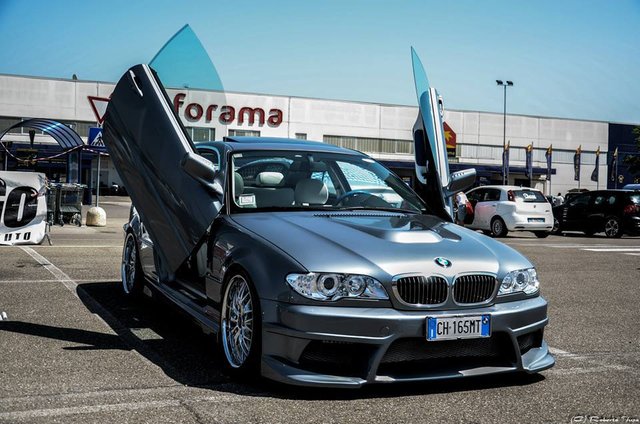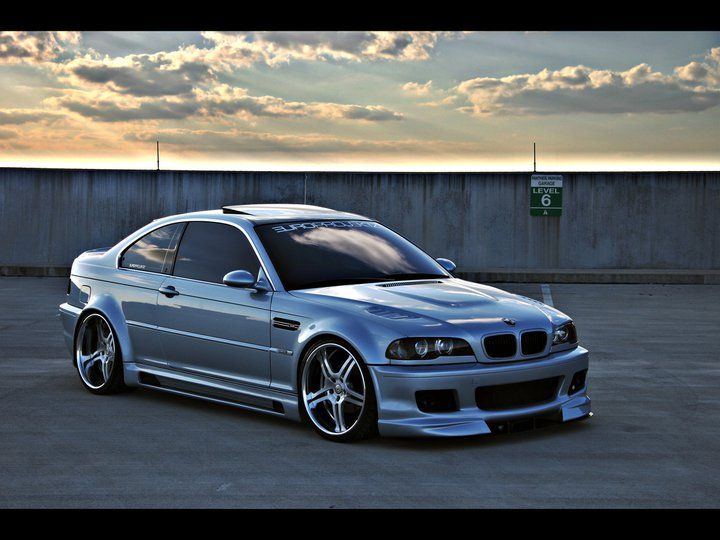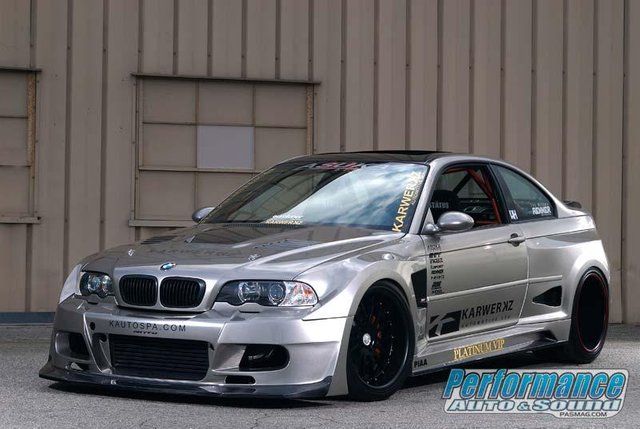BMW M3
It's finally here: an M3 as good as the Europeans get. After years of longing (and pleading, and whining) by North Americans, and after taking model year 2000 off, BMW is now exporting an M3 with a new 3.2-liter engine, bumping the horsepower up from 240 to 333. The icing on this cake was the price, reflecting an increase whose value was greater than its numbers. Introduced late as a 2001 model, the 2002 is essentially identical.
LINEUP
Would you like that with or without a hard top? Your choices are an M3 Coupe ($46,545) or an M3 Convertible ($54,565). The new M3 Coupe was first available as a 2001 model in the spring of 2001; the convertible followed in the fall of 2001, also as a 2001 model. For 2002, the most significant change is that the waiting list is shorter.
You'll pay extra for the pleasure of feeling the sun and wind on your face, but you'll also get Nappa leather cradling your body in the form of seats that are standard on the Convertible (and an $1100 option on the Coupe).
Both coupe and convertible come with a six-speed manual transmission (automatics are not available), huge ventilated disc brakes with ABS, and sophisticated electronic control of traction and stability. For safety, there are two-stage front airbags, side airbags in the doors, an inflating tubular head protection system, and a tire-pressure monitoring system. For your listening enjoyment, an in-dash CD player is standard in 2002.
The options list includes side-impact airbags for the rear seats ($385), Xenon high-intensity discharge headlights ($700), and a navigation system ($1800). Additional options for the coupe include Nappa leather, power moonroof, and power front seats. A cold weather package includes heated front seats, headlight washers and a ski bag.
The most spectacular option is the new Sequential M gearbox. It's similar in operation to the one used in the Williams-BMW Formula One cars that Juan Montoya and Ralf Schumacher drive. The sequential gearbox is operated either by the shift lever or with butterfly paddles on the steering wheel (one to upshift, one to downshift); it can be set to shift automatically or manually. The six-speed gearbox is technically the same as that used on manually shifted models, but there is no clutch pedal (nor is there a torque converter). Advanced engine electronics interrupt the engine's power for just milliseconds, the control unit opens and closes the clutch, and changes gears electro-hydraulically. When downshifting, the system automatically double-clutches. Computer logic allows the driver to individually match the system's shift characteristic to his preferred driving habits in eleven driving programs. LED lights aid shifting performance. We have not yet sampled this gearbox, but it is designed to produce 'a realistic Formula One experience,' while reducing shift times (to 80 milliseconds) and the chance of a missed shift. Car gazers who know a little bit about BMWs will recognize what this is: M3 means Magic. Even bystanders who don't know the difference between an M3 and a garden variety 3 Series Coupe might recognize that this car is hot. What gives it away: the deep front airdam with its vast opening, aggressive fender flares, the hunkered stance, massive low-profile Michelin Pilot Sport tires, the bulging hood (necessary to accommodate the engine), dual twin exhaust tips, even the horizontal air gills just below the windshield pillar. Still, these things actually look subtler than they sound on paper. But your speed as you blast by these bystanders and the sound of the engine might also be tip-offs. Maybe more like a telegraph.
One thing that came on early M3s is missing: a rear wing. There's just a teensy little spoiler on the rear deck. That tells us something, either about the aerodynamics of the M3 or the necessity of rear wings on road cars altogether. Because M3s are regularly driven at speeds well over 100 mph on the Autobahn, where they are perfectly stable, it can be safely assumed that with wings, teensy (okay, let's say subtle) is perfectly effective. For sure, the M3's understated rear spoiler sure looks better than some silly showy thing.
As for the Convertible, you lose the rear center seat to provide room for the top when it's dropped, but it's not much of a loss because that center seat is of little use anyhow. If you're willing to pay eight grand for sun in your face and wind in your hair ($6900 if you don't count the leather that comes with it), you'll be very happy with the top. It goes up and down with one button, no latches. It's concealed under a hard boot that looks like a soft tonneau cover. It has a thick lining for winter comfort. The glass rear window contains a defroster. Rollover protection bars behind the rear seats are automatically deployed if the car starts to tip. Can't ask for more than all that.
The wheels are distinctive, although this particular style-call it ten-spoke, call it twin-spoke, call it twenty-spoke-sure looks dark in satin chrome, as well as busy.
We're not sure if the wheels look confused or just strong, but we are sure the engine looks like it means business. Under the lightweight aluminum hood, the new S54 3.2-liter, double-overhead cam, inline-6 M powerplant is canted a few degrees toward the passenger side in order to fit under the hood. There's a big intake plenum, riding over six aluminum fuel injector butterfly bodies that look like sidedraft carburetors on an old racing engine. The big matt black valve cover bears its M Power badge on top, and the muscular radiator fan squeezed behind the twin-kidney grille adds to the look of racecar plumbing.
After we were done admiring the engine, we were very impressed (though not really surprised) by the feel of the fingertip slamming of the aluminum hood. How can something that light make such a solid sound when it thunks down? How? BMW quality fit.
INTERIOR
The M3 Coupe is considered a five-seater, but don't count on it. There's a reasonable amount of room in the rear, but the middle guy needs to be a midget to have any chance at comfort, as the transmission tunnel rises nearly to the height of the seat. The rear windows in the Coupe, our test car, are power operated, but it's almost an affectation, because they only open by flaring out a few inches at the back, as if to let stale air out, not fresh air in. Practically speaking, passenger-wise, the M3 Coupe fits between a two-plus-two sports car and a sports sedan. Of course, because it performs like a Porsche or Corvette, its seating might fairly be compared to either, in which case it offers much more. (Pressing a switch in the Convertible lowers or raises all four windows at the same time, handy on hot days or when raising or lowering the top.)
The coupe also offers a nice trunk, which is pre-wired for a garage door opener, CD player, security system and cell phone, all of which are BMW features installed by your dealer. What's more, one-third of the rear seat folds forward to gain trunk access, enabling the carrying of long things such as skis or, in our case, a two-piece windsurfing mast. (The convertible offers little in the way of trunk space.)
Rearward visibility is not very good, thanks to the sloping roofline (which may be worth it because the aerodynamics are so good), and the small, oval-shaped, rearview mirror that appears to be taken from a '40 Ford. Given the fact that M3 drivers will be checking their mirrors a lot, this is a curious place to add a touch of retro style, if that's the intent.
There's a terrific dead pedal, which will be used a whole lot because of the car's cornering capability. And the lateral support in the seats is ample, although our torso still shifted during hard cornering because the back of the seat was so wide-odd, since we found the BMW Z3's seats too narrow at the back. Makes us wonder if seat width is a direct function of car width; or maybe BMW has information indicating that M3 buyers are fatter than Z3 buyers.
Speaking of fat, the three-spoke steering wheel contains buttons for cruise control, the audio system and factory-installed phone, which makes it bulkier and less racy than the Audi TT steering wheel, for sure. The instrument panel is clean, with the interior trim in 2002 being changed for the better from Black High Gloss to Titanium Shadow. Also in 2002, there are new headrests to improve safety, and a new automatic climate control system.
The gauges are simple white-on-black; there's a 180-mph speedometer and 9000-rpm tachometer with a glowing red zone that lowers when the engine is cold. There are water temperature and fuel gauges, of course, but surprisingly no oil pressure gauge. The flat switchgear buttons are nice, including for the radio, which is nonetheless complicated enough to require its own manual (taking up much of the small glovebox).
The slim console doesn't hold much, but there are pockets in the doors, and two cupholders between the front seats, although the console compartment has to be raised to use the rear cupholder. We might comment more on such things, which might be considered shortcomings in a five-seat passenger car; except we'll assume that with M3 buyers, console space is not a priority. What matters is performance.
But before we get to driving impressions, we have two observations in that area where ergonomics meet performance. The gas pedal is so close to the gearbox tunnel that our right ankle rubbed on the tunnel when we blipped the throttle during downshifts. And the gearshift knob had an impractical shape, sort of like the head of a golfer's wood, which precluded a good solid grip. These two things flawed the ergonomics of downshifting. The soundbite: It doesn't get any better than this. The catch: But you gotta be going 90 miles an hour. The post script: In a curve.
But before you get there, you'll go from zero to 60 mph in 4.8 seconds, and after you get around that curve, if there's a real long straightaway, you might reach 155 mph. You and the engine might want to do more, but the engine management software won't let you go beyond that.
The most legal fun might be in accelerating to 70 mph on freeway onramps. The M3 loves to go through the gears, and you can actually hit redline at 8000 rpm in second gear before you have to back off to stay within the law. Second gear. So maybe you can't actually 'go through' the gears. You can always short shift, of course. But jeez it's hard, when the car is accelerating so sweetly, and it sounds so wonderful, and it really really really wants you to stretch its legs all the way up to eight grand. It shouts, sings to you, 'Please! Use me! That's what I'm here for! Don't let me down!' You're gonna deny it?
The exhaust note is what you might expect from a 3.2-liter, 333-hp inline-6. Inline-6s are known for their sweet sound. On a racing car, sometimes the sound can be spine-tingling (Jaguar), and sometimes it can be ear-blasting (Chevy TrailBlazer Baja truck). Inline-6s are not throaty nor beefy like a V8 (BMW M5). The M3 has a muted exhaust note, almost raspy. Like the rest of the car, it doesn't attract attention (not even your own) unless you're accelerating to 8000 rpm.
Seventy miles per hour in sixth gear is a mere 2650 rpm, but there's enough torque that if you floor it without downshifting (not that you would, this is just a test), you'll take off. If you're on a two-lane in a series of third-gear turns, with no gear changing, the engine responds like the world's most exotic and satisfying rheostat.
And then there's the Sport mode. Not to be confused with a transmission sport mode, it's described as Engine Dynamics Control by the manual, which adds that Sport mode will cause the engine to 'respond more spontaneously to the motion of accelerator pedal.' Oh really? We think maybe 'spontaneous' is not the word BMW was searching for, here.
Sport mode does indeed gas the car on its own, however. Not a lot, but if you're driving along at a steady speed and click the button on the instrument panel, the car will shoot ahead a bit as if a tiny afterburner had been lit. After that, the throttle response will be more aggressive. We like it. It's very practical, very functional. Simply, there are times when you don't want aggressive throttle response, times when you do.
The shifting linkage doesn't offer as short a throw as it might, but shifting is quite positive; the clutch action is especially and admirably smooth. It's easy to accidentally slip the gearbox into reverse if you're going from third gear to first, like when you come up to a red light that changes to green just after you stop.
If you want racier shifting, go for the optional sequential manual gearbox. It's the future.
Like the M5, the ride is amazing. No other carmaker that we can think of can design suspensions that corner like a racecar yet ride so comfortably, and the M sport suspension is specific to the M3. Definitely, it's firm; but we suspect it's a lot firmer than your butt thinks it is. If you know why you bought an M3, that firmness will be well worth the price of an occasional jab to the butt. Considering the handling you get for it, it's a steal.
At higher speeds you can feel the jabs, but not much, and they never move the car off its track. The M3 erases the bigger bumps at higher speeds better than it does the sharp ones at low speeds, however. There's one particular manhole cover near our house that we learned to brace ourselves for, when that left front wheel hit it at 25 mph. If ride quality is important to you, then you may find plenty of performance from the BMW 330i models (see separate NewCarTestDrive.com.
SUMMARY
Own an M3, and you can claim to own the best high-performance car on the market that isn't a total exotic. It's faster and grippier than a Porsche 911. But the best part may be that you won't have to make any significant compromises in civility. 3.2L I-6 Engine
6-spd man w/OD Transmission
333 @ 7,900 rpm Horsepower
262 @ 4,900 rpm Torque
Rear-wheel Drive type
ABS and driveline Traction control
18" silver aluminum Wheels
Front air conditioning, automatic
AM/FM stereo, seek-scan Radio
Keyfob (all doors) Remote keyless entry
Front Fog/driving lights
Heated mirrors
Windshield wipers - rain sensing
Cloth/leather Seat trim


wow!
that's the strength